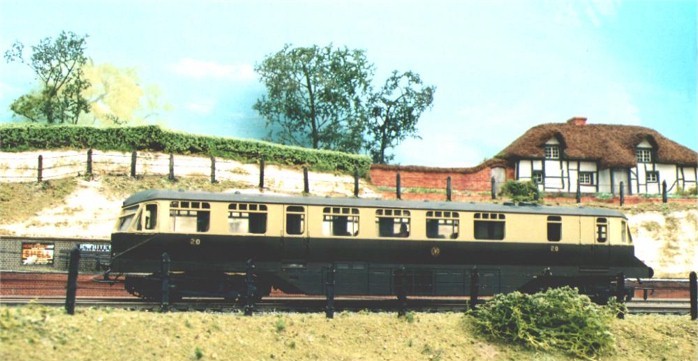 |
"No 20, the second of the GWR's 1940-built Diesel Railcars."
indent Having one of these rather
attractive beasts on the layout was a customer requirement. As the fore-runner of
today's DMUs they have a unique place in railway history and make a worthy model.
They also make an interesting change to the more familiar 14xx and auto coach but the
choice is rather more than a straight substitution; I'll explain why.
indent The first point is that the loco/coach combination is
longer but it was also more flexible since it could be separated into two units.
This was not done often however since the automatic control systems which allowed the
train to be driven from the coach end were time-consuming to connect and disconnect.
Where the engine was used for shunting purposes the auto coach was often left attached but
where this was not possible, for example shunting the gas-works siding at Wallingford, the
unit was often run with the gear only partly connected whereupon the fireman actually
drove the engine, the driver merely applying the brakes and sounding the bell if
needed. The point as far as layout design is concerned is that of handling tail
traffic. To enable this diesel to run round anything the neck at the end of the loop
must be long enough to take the whole unit (about 11½"), whereas if a 14xx is used
the neck need only be about 5".
indent The model is a slightly modified
Lima with a few added details. The main change has been to correctly add the proper
"quarterlights" to the windows between the windscreens and the coach sides.
These frames were originally painted black but were repainted cream at their first
"shopping" and I have seen no photos of this type with them black except
official photos taken before they entered service. Therefore I've painted
them cream. However, if you know of any war-time photos of them actually in service
with black quarterlights please let me have the references - and I'll get the brush
out! Finally, the old numbers were scratched away with a small glass-fibre brush and
new HMRS transfers fitted.
indent (Incidentally, Russell (GW Coaches Part ll)
states that these quarterlights weren't fitted from new but were added later. The
photos in his own book prove him wrong but he did such a valuable job in assembling
wonderful collections of photos featuring different types of GWR rolling stock that I can
not only forgive him the odd error but place on record my gratitude for the inspiration
this late author has given me over the years with his many, seminal works on these
matters. P.S. I can't get the brush for those windows now; the customer liked
No.20 so much he bought the model!)
| Previous photograph in series | Back to "Upper Isis Room" entrance | The Track Plan of Upper Isis. |